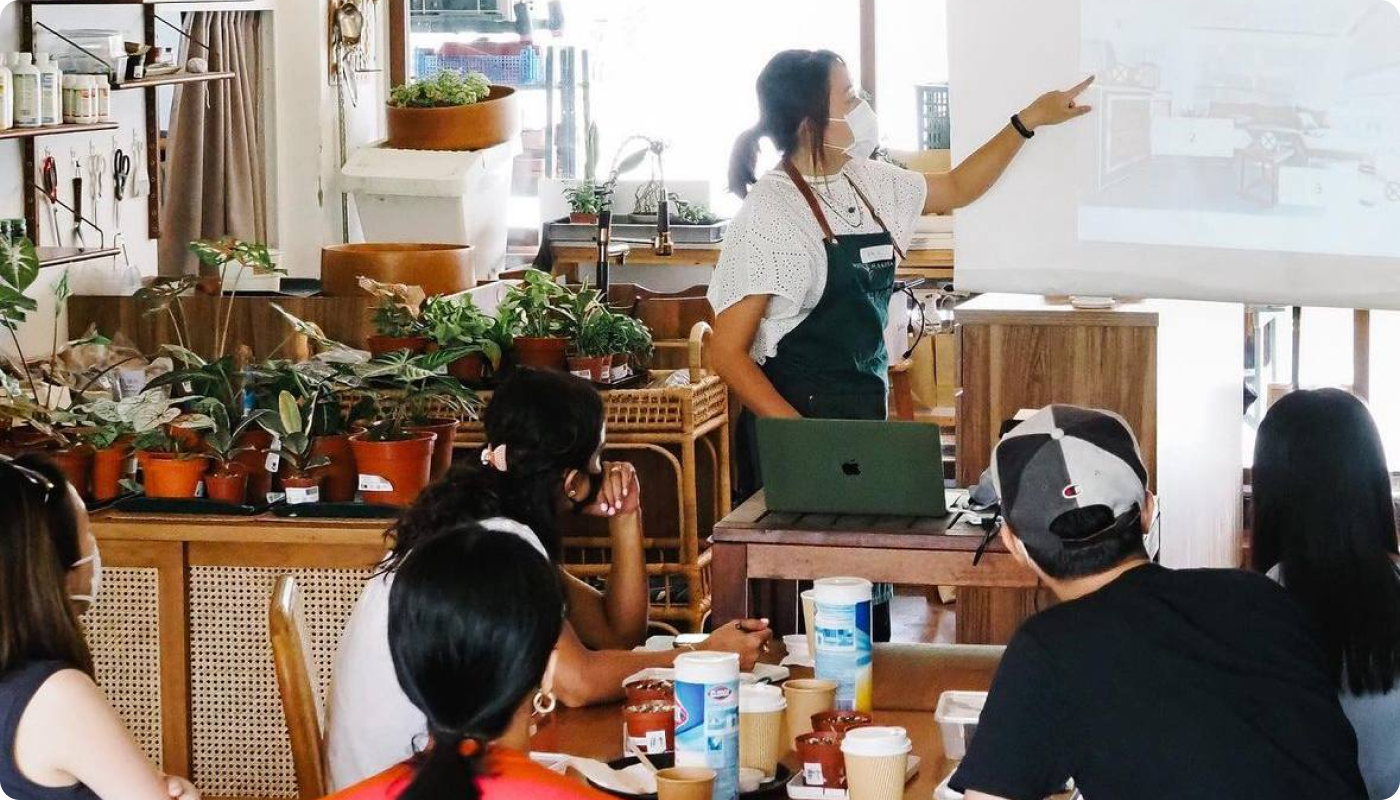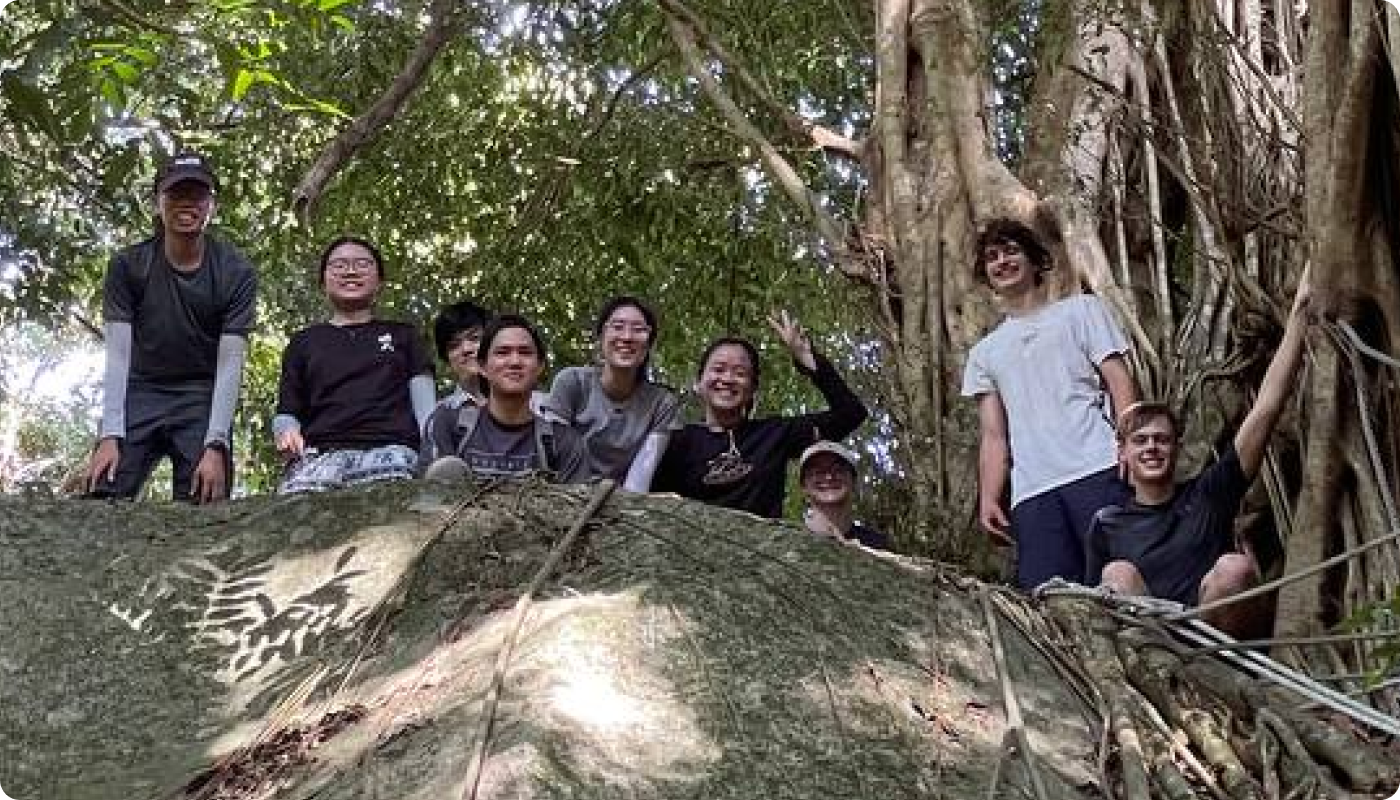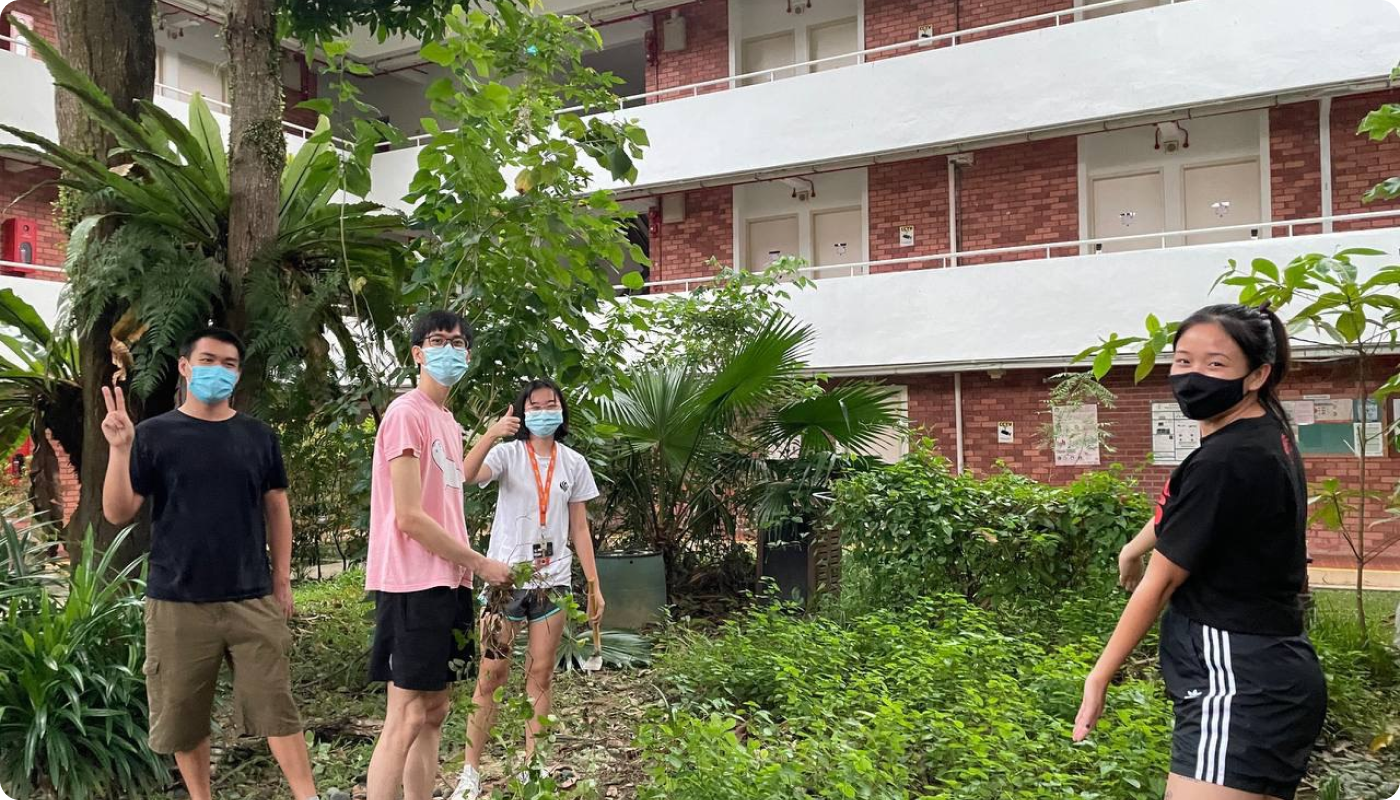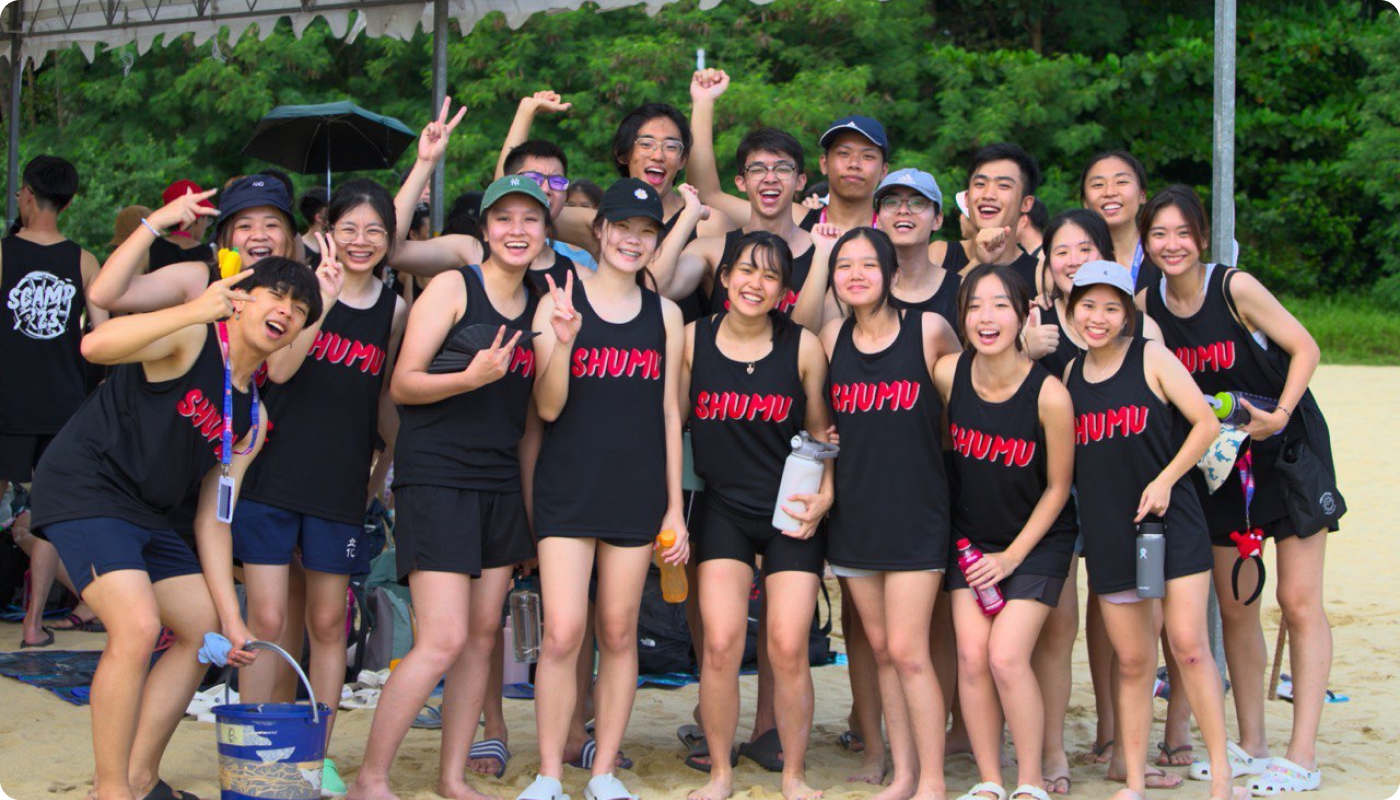For the love of plants
For 23-year-old Aristia Ho, her affinity with nature started in childhood when she lived at her grandmother’s house that had a garden – filled with fruit trees, water jasmines, orchids and pitcher plants hanging outside their windows. “I had a very green childhood, and used to play at the Bukit Timah Watten Heights playground almost daily. There was a trellis roof over the benches, with these gorgeous orange flowers in lush bloom all around me. To this day, that beloved image remains vivid in my mind,” the orchid-lover recounts with fondness.
But the pivotal point for Aristia into the world of nature was ironically, COVID. A self-confessed hoarder, the green thumb ended up importing and cultivating more than 250 plants into her home during the pandemic lockdowns. It was also during this period that the Humanities student applied to NUS College of Humanities and Sciences (CHS) – an enhanced undergraduate experience for students from NUS Faculty of Science (FOS) and NUS Faculty of Arts and Social Sciences (FASS) to gain essential foundational skills and broaden their intellectual foundations.
Plant stylist, curator, and doctor
At CHS, Aristia chose to major in Life Sciences from FOS, specialising in the Ecology, Environment and Biodiversity (EEB) track. She also took on a minor in Botany from FOS and a minor in Southeast Asian Studies from FASS. Being a Humanities student, it was initially hard for her to pivot to the Science track, so she took a gap year and worked at PottaPlantta in 2020 before enrolling in NUS when CHS was launched, because the new College opened more horizons for students with a passion for both the arts and sciences. Having always loved plants since she was young, it was her stint at PottaPlantta that really cemented her calling in this area. Pulling triple duty as a plant stylist, curator and 'doctor', her job was to create beautiful interior design arrangements to green up any space while providing customer-friendly plant care advice.

Aristia leading an interactive workshop with PottaPlanta clients,
exploring creative ways to transform plants into artful expressions.
“I discovered I really like touching soil and plants, as well as helping my customers pick their perfect plant in a perfect pot for that perfect spot! It gave me such a rewarding sense of satisfaction. Organising educational plant workshops also gave me practical insight into the running of a business, injecting a more pragmatic approach into my NUS education,” the Year 4 student shares.
Treasures in our own backyard
Since her Junior College days, Aristia has had a fascination with her home region, and so it was natural that she took on a minor in Southeast Asian Studies: “I am really drawn by the interplay between communities and natural spaces; the complexity is so fascinating to me. My friends from other countries in Southeast Asia share such vastly different lived experiences in nature from us here in Singapore!”
Noting the Western-centric focus in science, Aristia observes that the topic of Southeast Asian conservation and biodiversity is relatively less researched and underrepresented in scientific literature. She opines: “It’s a pity we don’t fully understand what we have in our backyard; our regional flora and fauna are what I am really interested in.” In fact, when asked what flower species she would salvage if all botanical life were to perish overnight, the aspiring horticulturist reveals: “I would save the Rafflesia, which is the biggest flower in the world. It holds a special allure for me; I have never seen it in my life and really want to!”
An interplay of arts and sciences
With her dual strengths in both the humanities and sciences, Aristia is a passionate advocate for interdisciplinary approaches to learning, and strongly believes that we need more arts in science, and more science in the arts. It is no surprise then, that this approach is also apparent in her research interests. Her honours thesis focused on how climate change impacts the seeds and seedlings of Singapore's native trees, while she had also clinched the NUS Southeast Asian Studies Exposure Course Prize as Best Performing Student in SE1101E: The Lands Below the Winds: Southeast Asia in the World, for her final essay: "Alternative Narratives Take Root: Planting the Seeds for Decolonisation in Gardens by the Bay’s Heritage Garden", which fused her interests in botany and cultural studies.
As a Gardens By the Bay (GBTB) scholarship holder, Aristia also cut her teeth in horticulture as she contributed to orchid breeding initiatives under the park’s orchid hybridisation programme to develop new orchid varieties, as well as streamlined data collection and analysis for orchid collections to improve accuracy in tracking and reporting.
Outside boxes, beyond labels
When asked about choosing between the Sciences and the Arts, Aristia is of the view that we should broaden our perspective. “For me, the science kits I played with as a child did it for me! Having said that, I have always had a creative streak and a love for aesthetics since young which translated into DIY projects like jewellery and crafts making. On that note, I feel that CHS students can best thrive when we abandon these false dichotomies and limiting labels of whether we identify as a Science or Humanities student. Knowledge is interdisciplinary, and the best outcome for thriving and learning is to blend both disciplines for synergy and impact,” she asserts.
Touting the biggest strength of CHS as the flexibility and diversity in choosing your own subjects and majors, Aristia feels that this allows students to clarify their preferences through the introductory courses before they decide. On her pro-tip for freshmen looking to thrive on campus, she offers: “Try to attend the freshman orientations and make many friends in your first year, it will ease your transition to college. At the same time, know your priorities and do not over-stretch yourself.”
From classroom to field trips
A CHS common curriculum course Aristia particularly enjoyed was HSA1000: Asian Interconnections where the history lover got to delve deeper into her Asian heritage and roots through fieldwork, as the course challenges underlying assumptions people may have about Asia.

Aristia (fourth from right) with students from University of California and Teaching Assistant Mr Carl Julius Bartels, in Tioman for LSM4263: Field Studies in Biodiversity. Together, they conducted surveys assessing the size and species of trees across forest successional zones, contributing to a deeper understanding of the island's lush ecosystem.
It was a pleasant surprise for Aristia when she discovered how research in EEB can be translated into informing real-life conservation policies. A notable course for her was LSM4263: Field Studies in Biodiversity where she did everything from formulation of the study to execution in-situ at Tioman. “It was invigorating for me to be out in the forests studying its biodiversity. Knowing what plant species you have is important for informing policies. In short, the whole study was a culmination of everything I have studied in these past few years,” she reflects.
Of seasons and temporal shifts
Beyond the NUS campus, Aristia considers her NUS Student Exchange Programme at Cornell University her most memorable experience thus far. Besides study tours to acclaimed botanical gardens, national parks, and art institutions, she also took courses in crop nutrition, environmental conservation, museum and park interpretation, biochemistry, and evolution. “I find the ‘Parks and Museum Interpretation’ class particularly enjoyable and relevant to my horticulture work at GBTB as it challenged me to be creative in crafting the storytelling behind the science data to deliver a compelling narrative to the public,” she offers.
Her stint in the United States has not only given Aristia a refreshing taste of freedom and independence, but also toughened her physically as her group of fellow NUS exchange students trekked across Yosemite, Death Valley and Grand Canyon National Parks together. They even got up close to the biggest trees in the world at Kings Canyon and Sequoia National Parks! Inspired by the breathtaking views, the adventurous go-getter proudly shares that her next goal is to train for Mount Merbabu closer to home.

One of the hikes that Aristia (middle) did with new friends she made on exchange, the Lands End Trail in San Francisco.
Aristia gleaned insights observing the seasonal shift from winter to spring, and gained a deeper awareness of the passage of time. She elaborates: “Experiencing the passage of time in horticulture was enlightening to me as we learn to work with, rather than against the seasons. I began to appreciate the ‘why’ behind the ‘what’ that you plant at different seasons.”
My safe space on campus

Aristia (first from right) with her fellow Green Rangers team mates at the RVRC gardening plot during the COVID period.
Besides academic pursuits, the sociable and extroverted go-getter also immersed herself into campus living at the Ridge View Residential College (RVRC). Crediting her friends at the Residential College as her ‘safe space’ in her freshman year, Aristia shares: “The comforting camaraderie amongst hall mates in this home away from home made my transition to university so much easier.” As a gardening enthusiast, Aristia was also the President of RVRC's GreenRangers interest group, where she advocated for sustainable, nature-centric solutions.
Being the Vice-President (Freshmen Orientation Projects) of NUS Science Club’s Management Committee was another milestone that positively shaped her personal growth. “The committee members worked closely together, and this taught me how to be strong and empathetic at the same time, tempering my leadership style to be less outcome-oriented and more people-centred. I matured in the process of managing this delicate balance,” she muses.

Aristia (back row, first from left) as Vice-President (Freshmen Orientation Projects) with fellow orientation group leaders and freshmen at Sentosa for NUS Science Camp (SCAMP) 2023.
My future eden
Regarding her ideal future home, the biophile enthuses: “I want a garden filled with plants and a pond with Koi and lilies. I want natural sunlight streaming into the warm inviting space of my house – complete with a cool greenhouse for highland plants, and staghorn ferns on a feature wall.”
A firm believer in inspiring others with a love of nature and a deeper understanding of the natural world, Aristia hopes that our city-state can evolve beyond a green city to become a city based in nature. “I wish more people could have what I was privileged to have growing up – surrounded by nature with a deeply personal relationship to it. Whether it is tending a plant you love, cooking the edible herbs you grow, planting a tree, or having your kids make a vegetable garden – these are the tangible interactions that help us build a precious emotional bond with nature all around us,” she muses.
